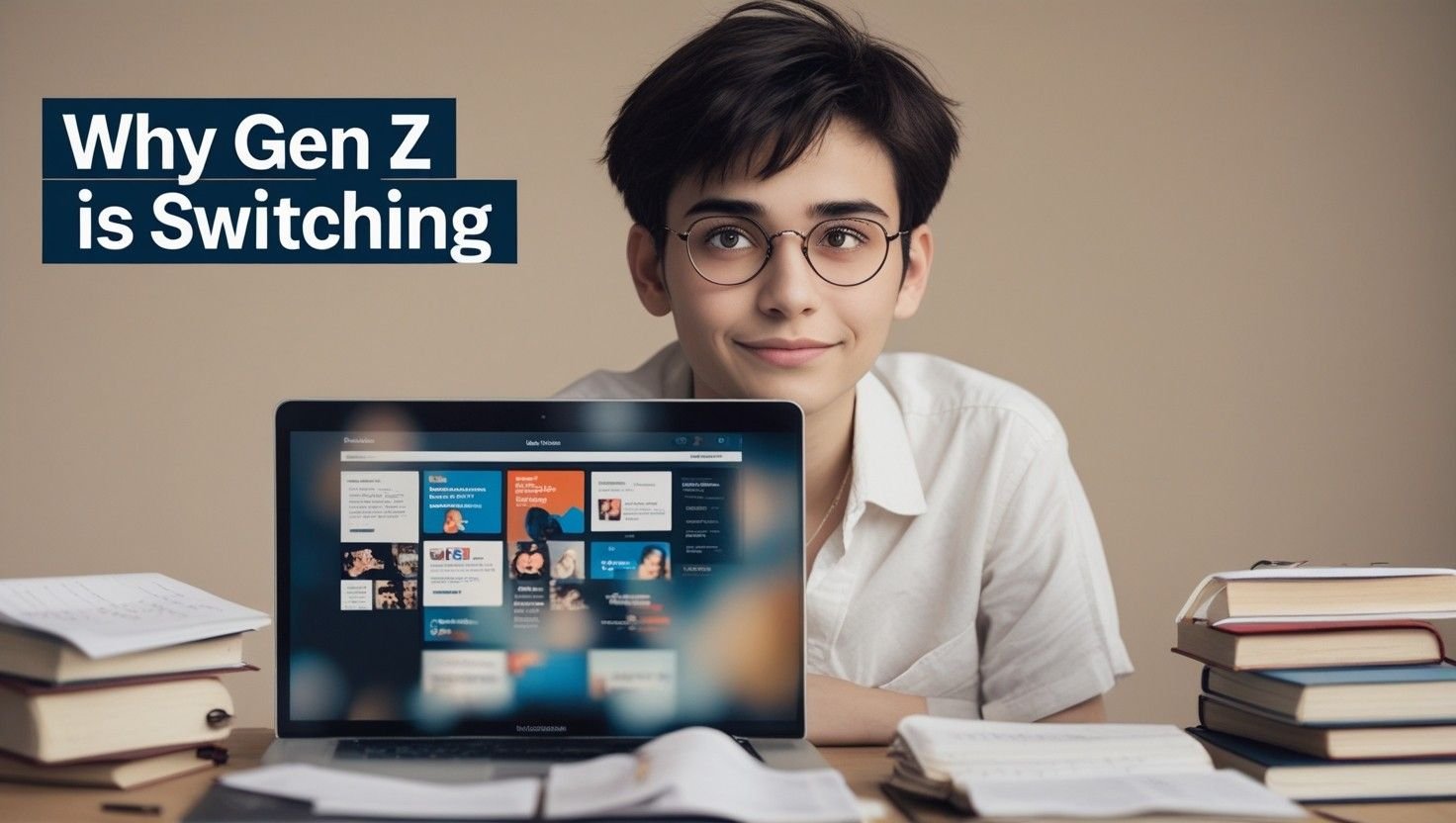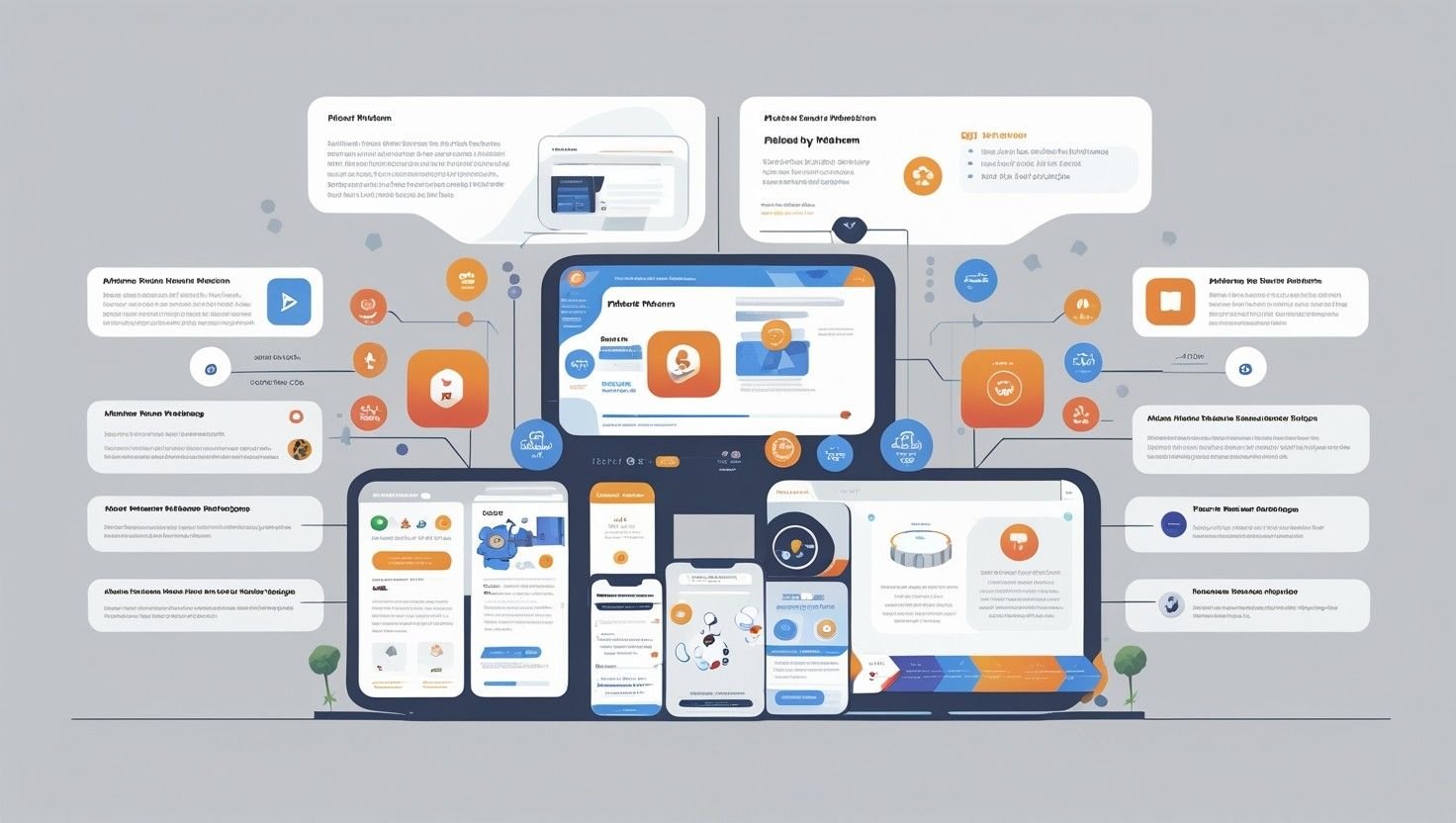 Gen Z isn’t “googling” less because they hate search—they’re searching differently be cause social platforms answer faster, more visually, and with people they trust. For everyday decisions—where to eat, what to buy, how to fix something—Zoomers increasingly start on TikTok, Instagram, YouTube, and Reddit, where short videos, carousels, and comment threads compress discovery, proof, and instruction into a single scroll.
Gen Z isn’t “googling” less because they hate search—they’re searching differently be cause social platforms answer faster, more visually, and with people they trust. For everyday decisions—where to eat, what to buy, how to fix something—Zoomers increasingly start on TikTok, Instagram, YouTube, and Reddit, where short videos, carousels, and comment threads compress discovery, proof, and instruction into a single scroll.
Creator reviews feel more authentic than blue links, social graphs filter relevance better than generic SERPs, and algorithmic feeds surface trends before queries are even typed. Add native search bars, topic hubs, and shoppable posts, and social becomes both the front door and the final aisle of the journey. The implications are profound: SEO is no longer Google-only; brands must optimize for social intent, structure content for in-feed answers, build creator-led proof, and treat community signals—saves, shares, watch time—as the new ranking factors. In the Gen Z era, search is social, discovery is continuous, and credibility is earned in public, one swipe at a time.
Introduction
Gen Z’s daily search habits have shifted from traditional engines to social platforms where answers are visual, fast, and shaped by real people. On TikTok, YouTube, and Instagram, question-led content—like “how to style cargos,” “best budget smartphones,” or “cafes near me”—surfaces immediately through short videos, carousels, and creator explainers. This behavior is Replacing Google for Gen Z in the earliest stage of discovery, especially for lifestyle, local, and product queries where authenticity and demonstration matter more than long-form text. The result is a new search journey that starts with social feeds, validates insights via comments/UGC, and only later moves to deep-dive sources if needed.
What’s happening: Gen Z increasingly searches TikTok, YouTube, and Instagram for answers before Google.
Social platforms have matured into functional search layers, with autosuggest, keyword indexing in captions/on-screen text, and “related” result clusters that mirror search intent. For Gen Z, this experience feels more intuitive because it’s native to how they consume content: swiping through bite-sized, high-signal answers rather than scanning links.
Visual proof is the default. A 30–60s clip showing the outcome—skin results, recipe steps, a restaurant walkthrough—reduces effort and increases trust. This immediacy is central to why social search is Replacing Google for Gen Z during the “what should I try?” phase.
Community validation happens in real time. Comments act as follow-up queries, creators pin clarifications, and duets/remixes provide counterpoints. This dynamic, conversational loop gives Gen Z the sense of a living FAQ rather than a static results page.
Platform mechanics reinforce search behavior: TikTok’s For You feed and search tab, YouTube’s Shorts + long-form pairing, and Instagram’s Reels + Explore make it easy to both discover and refine queries without leaving the app.
Why it matters: Traditional SEO alone no longer guarantees visibility—social-first discovery dominates product, local, and lifestyle searches.
Many high-intent queries for Gen Z now begin on social: beauty routines, fashion hauls, fitness plans, gadget picks, recipes, and neighborhood spots. If brands aren’t present with native, searchable content, they’re invisible at the moment of inspiration—even if they rank on Google.
Ranking factors have changed. On social, “SEO” is driven by engagement signals (watch time, completion, saves, shares, meaningful comments), relevance signals (on-screen keywords, captions, alt text, hashtags, geotags), and creator authority (topic consistency, audience trust). Mastering these is critical because social results are increasingly Replacing Google for Gen Z at the top of the funnel.
The conversion path is nonlinear. A viewer may discover a product on TikTok, verify details via creator comments or a longer YouTube review, then search brand terms later. This means social content not only sparks demand but also influences branded search volume and purchase confidence downstream.
Local businesses are especially affected. Quick, geo-tagged walk-throughs, price boards, menus, and service demos often outperform static listings, shifting “near me” discovery to social clips and carousels.
The new playbook: Keyword-rich short-form videos, Reels/Shorts, and carousels that directly answer questions (e.g., “best skincare for teens”)
Start with question-led hooks. Build videos around natural-language queries that Gen Z actually types or says: “best skincare for teens,” “cheap veg eats in Andheri,” “iPhone vs Pixel for camera,” “how to clear acne scars.” This aligns with how social search is Replacing Google for Gen Z in everyday problem-solving.
Make answers scannable in-video. Use on-screen text for primary keywords, show the outcome first, and structure steps visibly (1–2–3). Add relevant geotags for local intent and price/context overlays to reduce follow-up questions.
Optimize metadata natively. Write captions like mini answers, include synonyms and long-tail phrases, add alt text where available, and choose a cover frame that matches the query. On YouTube, pair Shorts for quick answers with a linked long-form breakdown and chapters.
Build interaction loops. Pin a comment with key takeaways and links, turn recurring questions into new clips, and stitch/duet credible counterpoints to strengthen trust. Saves and comments are strong signals that improve search appearance over time.
Map content to the full journey. Use short-form to spark discovery, carousels for comparisons, and long-form videos or blog posts for deep dives. Cross-pollinate: Shorts/Reels tease, long-form explains, carousel summarizes. This blended approach wins attention where social is Replacing Google for Gen Z while still capturing later-stage research traffic.
The Shift in Numbers
Social-first discovery is no longer a fringe behavior—it’s Replacing Google for Gen Z in early-stage search across product, local, and lifestyle queries. Multiple independent datasets converge on the same pattern: young users are defaulting to TikTok, Instagram, and YouTube when they need fast, visual, and community-validated answers.
Social-first search adoption: Aggregated analyses referencing campus audience research and market coverage report that roughly half of Gen Z prefers TikTok/Instagram for discovery over traditional search. This preference signals that social content formats—short video, carousels, creator explainers—are actively Replacing Google for Gen Z at the “what should I try?” moment.
Platform usage for search: In U.S. survey data focused on local discovery among 18–24-year-olds, Instagram and TikTok slightly edge past Google, with percentages in the mid-to-high 60s for social platforms and low 60s for Google. This close but meaningful lead highlights how visually rich, geo-tagged clips and creator tours are Replacing Google for Gen Z when choosing restaurants, salons, and neighborhood activities.
Google’s own data point: Public comments from company leadership have acknowledged that about 40% of younger users may choose TikTok or Instagram over Google Search or Maps for certain local queries. This admission reinforces the structural shift: social interfaces are Replacing Google for Gen Z where immediacy, visuals, and peer validation drive confidence.
Teen platform penetration: Teen adoption sits near universal levels for YouTube, with TikTok and Instagram seeing heavy daily use. With such saturation, it’s natural that search-like behaviors migrate in-app—watching quick how-tos, scanning creator reviews, and skimming comment “FAQs”—thereby Replacing Google for Gen Z in routine decisions before any web search occurs.
What these numbers collectively show is a funnel inversion: discovery originates inside social feeds, intent is shaped by creators and comments, and only later—if needed—do users deepen research elsewhere. For marketers, the implication is clear: optimize natively for social search signals (watch time, saves, comments, on-screen keywords) because this is where social is already Replacing Google for Gen Z at scale.
Why Gen Z Is Switching
Gen Z’s search behavior is shaped by how they learn, judge credibility, and make everyday decisions in social environments—factors that are increasingly Replacing Google for Gen Z at the earliest stage of discovery.
Visual-first learning: Short, video-native answers compress the time-to-insight. A 30–90s clip showing the result first—before/after skincare, a recipe walkthrough, or a camera test—beats scanning multiple blue links and long articles. The format matches how Gen Z consumes information on mobile: rapid, outcome-led, and easy to compare. This immediacy is a core reason social search is Replacing Google for Gen Z when they just want to see “what works” without reading through dense text.
Authenticity and UGC: Creator content, peer reviews, and real-world demos feel more trustworthy than polished ads or generic SEO pages. Viewers can assess credibility through the creator’s track record, transparent process, and community feedback in comments. When hundreds of users corroborate results or share pitfalls, it creates social proof that’s difficult to replicate on traditional search results—further Replacing Google for Gen Z in product and routine decisions.
Community discovery: Engagement-driven feeds surface relevant answers before a query is even typed. As users watch, like, save, and comment, the algorithm learns their intent and proactively delivers “what to try next.” Comments function as living FAQs, with creators pinning clarifications, updating advice, and stitching counterpoints. This conversational loop feels like a real-time help desk and is a key reason this behavior is Replacing Google for Gen Z during exploration.
Local and lifestyle fit: Social shines where proof matters—restaurants, salons, fashion, beauty, travel, and micro-trends. Geo-tagged clips, price overlays, menu scans, and quick tours provide tangible signals that reduce uncertainty. For neighborhood choices like “best momos in SDA” or “budget hair spa in Bandra,” a reel or TikTok delivers faster confidence than map listings alone, which is why social results are Replacing Google for Gen Z in everyday local discovery.
The throughline is clear: speed, proof, and peer validation. When answers are visual, verified by a community, and presented in the exact formats Gen Z already prefers, social search becomes the default starting point—effectively Replacing Google for Gen Z for top-of-funnel questions across lifestyle, local, and product categories.
Where Social Beats Google (Use Cases)
Social platforms excel wherever speed, visual proof, and peer validation matter—practical scenarios where decision-making is fast and contextual. In these moments, social results are naturally Replacing Google for Gen Z because they offer outcomes-first content, authentic demos, and community feedback in the same feed.
Product discovery and reviews: Short video demos and side-by-side comparisons let viewers see performance in real time—texture tests for skincare, camera low-light comparisons, or “what’s in my bag” for everyday carry. The “dupes” culture thrives here by offering transparent, price-sensitive alternatives with visual receipts. Because creators show results, caveats, and practical usage in 30–90s clips, social content is Replacing Google for Gen Z at the moment of browsing and shortlist building.
Local intent: For choices like “Best coffee in Bandra” or “budget hair spa in Andheri,” reels and TikToks provide fast confidence through walk-throughs, menus, price boards, and ambience checks. Geo-tags, captions with neighborhood names, and map overlays reduce friction and help viewers visualize the experience before visiting. This immediacy and context are Replacing Google for Gen Z for everyday “near me” discovery, where authenticity and recency matter more than static listings.
How-tos: Recipes, skincare routines, DIY fixes, and study hacks work best when viewers can copy steps visually. Tight edits, on-screen steps, ingredient labels, and before–after moments compress learning into minutes. Comments function as live FAQs—adjusting quantities, suggesting substitutions, or warning about pitfalls—which is why social tutorials are Replacing Google for Gen Z when they want clear, replicable guidance without wading through long articles.
Trend tracking: Viral formats, sounds, filters, and hashtags reveal what’s culturally hot before it appears in web search trends. Creators seed micro-trends—new ingredients, niche aesthetics, budget challenges—that spread via stitches and remixes. Because discovery is algorithmic and participatory, social platforms surface these waves earlier, effectively Replacing Google for Gen Z as the first place to spot, evaluate, and join trends in real time.
In each case, the common thread is proof over promise: social shows the outcome, captures real context, and layers in community validation—precisely why it’s Replacing Google for Gen Z for product, local, how-to, and trend-led queries.
Platform-by-Platform Mechanics: Proven Strategies
Gen Z’s discovery flow is shaped by each platform’s native search surfaces and ranking signals. Mastering these mechanics is essential because social search is increasingly Replacing Google for Gen Z at the very start of the journey.
TikTok: On-screen keywords and spoken phrases help the system parse intent, while captions framed as questions (“best toner for oily skin?”, “cafes near Bandra station?”) align with how people search. Comments act as living Q&A, where creators pin clarifications and update answers, and playlists bundle tutorials into step-by-step series. Adding geo/local tags improves visibility for neighborhood queries. This tight loop of query → visual proof → community validation is a key reason TikTok is Replacing Google for Gen Z for quick, practical decisions.
Instagram: Reels surface in both the feed and Explore, with indexing influenced by captions, alt text, and a few precise, niche hashtags. Carousels designed for “saves” (checklist slides, comparison grids, mini-guides) signal usefulness to the algorithm, earning more search appearances. Because it blends aspirational visuals with actionable info in compact formats, Instagram is Replacing Google for Gen Z when they want fast comparisons and local inspiration without leaving the app.
YouTube: Shorts capture fast queries with results-first edits, while long-form videos deliver depth and credibility. Chapters and timestamps create “intent jumps,” letting viewers skip directly to answers (e.g., camera low-light test, ingredient breakdown, price segment). This pairing—snackable discovery plus authoritative detail—explains why YouTube remains central even as social is Replacing Google for Gen Z: it satisfies both quick checks and thorough research within the same platform.
Reddit/Discord: Topic-focused communities provide credibility through collective experience. Searchable threads, flairs, and pinned FAQs make it easier to find vetted answers, while upvotes and mod guidelines curb low-quality responses. Discord channels add real-time back-and-forth, turning troubleshooting and recommendations into collaborative workflows. For niche and technical questions, this communal vetting process is increasingly Replacing Google for Gen Z because it feels like asking trusted experts rather than skimming generic results.
Across these platforms, the throughline is native SEO: question-led hooks, clear on-screen keywords, helpful captions/alt text, and formats optimized for saves and meaningful comments. When executed well, this ecosystem of visual proof and community feedback becomes the default starting point—effectively Replacing Google for Gen Z for discovery across local, product, and how-to queries.
How Social Algorithms “Rank” Search
Social feeds increasingly act like search engines, prioritizing content that proves useful and relevant in real time—one reason this behavior is Replacing Google for Gen Z at the start of discovery.
Engagement signals: Algorithms reward retention and meaningful interactions more than vanity metrics, with watch time, completion rate, saves, comments, and shares carrying significant weight across short-form video surfaces like Reels, TikTok, and Shorts. Early engagement and dwell time also inform distribution, pushing content that holds attention and sparks conversation, which helps explain why social results are increasingly Replacing Google for Gen Z for fast answers.
Relevance signals: Platforms parse multiple modalities to understand intent—on-screen text (OCR), spoken keywords (speech-to-text), captions, alt text, and targeted hashtags—to match natural-language queries with content. Optimizing these fields with question-led phrasing and location tags improves search appearance within each app, making social content more discoverable and effectively Replacing Google for Gen Z for everyday “how-to” and local queries.
Authority signals: Creator credibility is inferred from consistent posting in a niche, audience quality, community interaction, and sentiment in comments, which collectively boost ranking likelihood. Niche-focused creators and micro-communities often see higher engagement rates and trust, reinforcing why community-vetted answers on social are Replacing Google for Gen Z when they seek practical, trustworthy guidance.
Across platforms, the common thread is clear: content that keeps viewers watching, answers specific questions in their own words, and earns saves and substantive comments rises to the top—making social search feel faster, more useful, and more credible, and thus Replacing Google for Gen Z in early-stage decision-making.
Implications for SEO and Search Strategy
As discovery shifts to social surfaces, the mandate is clear: treat TikTok, Instagram, YouTube, and Reddit like search ecosystems, not just distribution channels. This is where short, useful, and native content is Replacing Google for Gen Z at the start of the journey—and strategy must adapt accordingly.
SEO expands beyond Google: Optimize for each platform’s native search signals. On TikTok and Instagram, align on-screen text, captions, alt text, and hashtags with natural-language queries (e.g., “best moisturizer for oily skin teens,” “budget cafes in Bandra”). On YouTube, pair Shorts for quick answers with long-form breakdowns, using keyword-rich titles, descriptions, and chapters. On Reddit, craft descriptive, problem-led titles, use flairs, and contribute credible, non-promotional answers that earn upvotes and saves. This multi-surface approach acknowledges that social content is Replacing Google for Gen Z in top-of-funnel discovery, so visibility must be earned in-feed and in-app search—not only on web SERPs.
SERP fragmentation: Expect non-linear paths. A typical flow looks like social discovery → deeper verification on YouTube/Google → community validation on Reddit or in comments. Plan content to meet users at each stage, recognizing that early influence is happening where social feeds are Replacing Google for Gen Z. Monitor branded search lift after social spikes, track “appears in search” metrics in-app, and connect comment FAQs to content updates so the entire system learns and improves.
Content architecture: Build short-form “answers” that ladder up to long-form explainers and guides. Start with question-led clips that deliver the outcome first, backed by on-screen keywords and concise steps. Summarize comparisons in carousels designed for saves. Link to deeper resources—YouTube chapters, blog guides, or FAQs—so those who need more can dive in without leaving the ecosystem. This layered approach works because it mirrors real behavior: quick social answers are Replacing Google for Gen Z at the moment of inspiration, while longer formats support evaluation and decision-making later.
The strategic takeaway: native, query-led content wins the first click in social feeds. By optimizing for platform-specific signals, mapping the fragmented path, and structuring content from short-form answers to long-form depth, brands remain discoverable exactly where social is Replacing Google for Gen Z.
Social-First Search Optimization (Step-by-Step)
Gen Z’s discovery starts inside social feeds, so optimization must be native to each platform’s search surfaces—precisely where social is Replacing Google for Gen Z at the moment of inspiration.
Keyword research
Mine platform autosuggest: Type seed phrases like “best moisturizer for teens,” “budget cafes in Bandra,” or “how to clear acne scars” to capture real query variants and long-tail language that signals intent in short-form content. These high-intent, natural phrases are the building blocks for content that’s actively Replacing Google for Gen Z in everyday searches.
Scan popular questions in comments: Pull recurring objections, confusions, and “vs.” comparisons from high-engagement posts—then convert them into standalone clips and carousels. Comment-derived phrasing mirrors how audiences actually search.
Track niche hashtags and topic labels: Balance broad discovery tags (#skincare, #mumbaifood) with specific intent tags (#oilySkinRoutine, #BandraBrunch, #acneScarTreatment). Combine 1–2 broad + 2–3 niche tags to anchor relevance without appearing spammy.
Content production
Lead with questions and outcomes: Start TikTok/Reels/Shorts with a clear hook that mirrors search intent (“Best sunscreen for humid summers,” “How to shoot low light on budget phones”). Reveal the result or key takeaway within the first 3 seconds to earn retention—critical as short video is Replacing Google for Gen Z for quick answers.
Use on-screen keywords: Add the exact query and key terms as large, readable text in the first frames; reinforce verbally so speech-to-text captures them. Keep framing tight and edits punchy to maximize completion rate.
Show proof, not just claims: Demonstrate steps, side-by-side comparisons, price overlays, maps/geo context, or before–after shots. Visual evidence increases saves and shares, which boosts in-app search appearance.
Metadata and accessibility
Write natural-language captions: Summarize the answer in 1–2 sentences using the target query and synonyms; avoid keyword stuffing. This helps content surface for multiple phrasings while staying human.
Add alt text and chapters: Where supported, include descriptive alt text with the primary query and outcome; on YouTube, add chapters labeled with intent (“Ingredients,” “Camera test,” “Pros/cons”) to enable fast jumps from Shorts to depth.
Use location tags for local intent: Pair neighborhood and landmark tags with on-screen city/area names to strengthen local ranking—especially effective as social results are Replacing Google for Gen Z for “near me” moments.
Interaction loops
Pin answers in comments: Drop a concise TL;DR, product list, or step summary as the top comment; update it as viewers ask follow-ups. This creates a living FAQ that compounds search relevance.
Turn FAQs into new clips: Convert recurring questions and objections into bite-sized follow-ups; stitch/duet credible counterpoints to build trust. Series playlists make discovery bingeable.
Cross-link Shorts ↔ long-form: Publish a quick, results-first Short/Reel and reference or link to a full breakdown (YouTube long-form, blog guide) for those who want depth. This mirrors real journeys where social is Replacing Google for Gen Z for first-touch, then deeper research happens in the same ecosystem.
Track saves and search appearance: Monitor in-app analytics for “appears in search,” saves, and completion rate; double down on topics and formats that consistently lift these signals.
When executed together—query-led hooks, visible proof, precise metadata, and comment-driven iteration—this system meets audiences where social is Replacing Google for Gen Z and compounds visibility across platforms.
Local SEO Goes Social
Local discovery now starts inside social feeds, where short, visual posts reduce friction and build instant trust—one reason this behavior is Replacing Google for Gen Z for “near me” decisions across food, salons, fitness, and services.
Geo-tag content and use local keywords on-screen/captions for neighborhoods and landmarks: Pair precise geo-tags with readable on-screen city/area names (e.g., “Bandra Pali Hill,” “Indiranagar 12th Main,” “Connaught Place Block M”) and include landmark cues (“near Carter Road,” “opposite Phoenix Marketcity”) in captions. This dual tagging helps social algorithms disambiguate neighborhoods and align posts with hyperlocal queries, which is exactly where social content is Replacing Google for Gen Z when they’re choosing spots quickly.
Show IRL proof to cut research friction: Film walk-throughs that cover approach, ambience, seating, hygiene, and peak-hour vibes; overlay menus, price tags, service lists, and timings; capture staff interactions and service steps (e.g., hair spa stages, latte art, portion sizes). These receipts compress decision-making into 30–60s and drive saves—making visually verified posts more persuasive and effectively Replacing Google for Gen Z for everyday local choices.
Build review gravity through engagement: Prompt viewers to drop specific tips (“best dish to try,” “quiet corners for work,” “ask for X add-on”), reply with time-stamped clarifications, and pin a top comment summarizing key info (price range, wait times, must-try items). Encourage users to save the post as a mini-guide and update the comment if menus or prices change. Dense, helpful comment threads signal local relevance to the platform and keep content recirculating in search—another way social results are Replacing Google for Gen Z at the neighborhood level.
Operationally, anchor each local post around a clear query (“best filter coffee in Indiranagar,” “budget hair spa Bandra”), show proof first, and optimize with geo-tags plus landmark keywords. Over time, a cadence of saved guides, responsive comments, and updated info compounds visibility where social discovery is Replacing Google for Gen Z.
Measurement and Attribution
As social discovery keeps Replacing Google for Gen Z at the top of the funnel, measurement must shift from pageviews to in‑app performance signals and downstream demand capture.
New KPIs: Prioritize saves, shares, watch completion, meaningful comments, profile clicks, and “appears in search” metrics. Saves indicate utility, shares indicate advocacy, completion reflects content-market fit, and high-quality comments (questions, comparisons, testimonials) validate relevance. Profile clicks show intent to explore more, while “appears in search” confirms that native SEO (on‑screen keywords, captions, tags) is working—critical when social is Replacing Google for Gen Z for first-touch discovery.
Demand signals: Monitor branded search lift and direct traffic immediately following viral or high‑retention social posts. Spikes in brand queries, product page visits, and DMs/inquiries often lag by hours to days after social performance peaks. Tag campaigns and map timelines so it’s clear which Shorts/Reels/TikToks catalyzed demand—evidence that social is Replacing Google for Gen Z at the inspiration moment and pushing users to verify or purchase later.
Content‑market fit: Use comment questions to script follow‑up clips and carousels, address objections, and expand FAQs; analyze watch drop‑off timestamps to fix hooks, pacing, or structure; review search appearance logs to double down on phrasing that consistently triggers in‑app discovery. This iterative loop compounds visibility where social is Replacing Google for Gen Z, aligning creative decisions directly with what audiences are searching and saving.
Operationally, build a lightweight dashboard that marries in‑app analytics (saves, completion, search appearance) with web signals (brand search, direct traffic, add‑to‑cart) on a shared timeline. Tie each creative asset to a query intent and evaluate performance by how effectively it wins the social first click, since that’s the moment social is Replacing Google for Gen Z.
Risks and Editorial Standards
As social search keeps Replacing Google for Gen Z at the earliest stage of discovery, editorial rigor becomes a competitive advantage. Applying clear standards protects audience trust and reduces the risk of harmful or misleading advice.
Accuracy and misinformation: Treat every claim as publishable journalism. For how-tos, product benefits, or data points, add source references directly in captions or a pinned comment, and link to primary materials where possible. Avoid health, skincare, fitness, or financial claims without credible citations and clear qualifiers; when sharing personal results, label them as individual experiences, not guarantees. This transparency helps audiences distinguish proof from opinion—critical when social content is Replacing Google for Gen Z as a first source of answers.
Disclosure and ethics: Clearly flag sponsorships, gifted products, affiliate links, and any material relationships in the first lines of captions or with an on-screen label. Maintain a consistent disclosure format across platforms and keep editorial voice separate from paid talking points. Disclose edits (e.g., sped-up steps, artificial lighting) that could affect perceived results. Ethical clarity sustains credibility in feeds where promotional and informational content blend—and where social videos are Replacing Google for Gen Z during product evaluation.
Inclusivity and accessibility: Add accurate captions (not just auto), descriptive alt text, and readable on-screen text with sufficient contrast. Localize key posts with regional terms, measurements, currencies, and subtitles where relevant, especially for local and travel content. Show diverse skin tones, hair types, body types, budgets, and locales when demonstrating products or services. Accessibility and representation ensure that content remains useful and trustworthy at scale—vital as social platforms are Replacing Google for Gen Z for everyday decisions.
Operationally, establish a pre-publish checklist: verify claims with sources, confirm disclosures are present, ensure captions/alt text are complete, and run a quick readability/contrast check on on-screen text. This lightweight process preserves speed while upholding standards in the very ecosystem that’s Replacing Google for Gen Z.
Sector Playbooks: High-Impact Tactics
Social platforms reward formats that show outcomes fast, anchor to real queries, and invite community input—one reason these playbooks are naturally Replacing Google for Gen Z at the moment of discovery.
Beauty/skincare: Break routines into step-by-step clips with clear goals (acne control, oil control, barrier repair), and front-load results in the first 3 seconds. Use ingredient explainers (niacinamide vs salicylic acid), texture tests on skin, and before–after sequences under consistent lighting to build trust. Pair premium picks with transparent price/dupe comparisons, labeling who each option suits (skin type, climate, budget). On-screen keywords like “best sunscreen for humid weather” and captioned routines (“AM routine for oily, acne-prone skin”) help these videos surface in-app—precisely where short, visual proof is Replacing Google for Gen Z for quick product decisions.
Food/local: Package “A day eating in…” neighborhood tours with geo-tags, landmark mentions, and price overlays to cut decision friction. Best-of lists (under ₹300 breakfasts, late-night eats, veg thalis) and budget challenges deliver shareable, save-worthy guides. Use map overlays and chaptered captions for each stop, plus ambient clips (queue length, seating, noise levels) so viewers can pre-vet the experience. This IRL proof—menus, portions, ambience—makes social posts feel like a live review, effectively Replacing Google for Gen Z for “near me” choices.
Tech/gadgets: Lead with Shorts/TikTok demos showing outcomes users care about: low-light camera tests, battery drain timelapses, gaming thermals, speaker loudness, and side-by-side comparisons with on-screen spec cards. Then funnel to long-form YouTube for deeper analysis, chapters for intent jumps (camera, performance, software updates), and pinned FAQs addressing common objections. For troubleshooting and buying advice, summarize solutions in short clips and link to community-backed threads for edge cases. This blend of quick proof plus detailed follow-up mirrors how social is Replacing Google for Gen Z from first look to final decision.
The Competitive Landscape
As social feeds become the default entry point for discovery, a three-way race is underway between web search, social platforms, and AI assistants—shaping where attention flows and why social is Replacing Google for Gen Z at the first-touch moment.
Google’s response: More visual, immersive results and AI features are being pushed to keep younger users engaged, including richer local modules, creator-led snippets, and AI-generated summaries that reduce the need to click through multiple links. These moves aim to compress time-to-answer and bring the “show me, don’t tell me” experience into search—directly addressing why social formats are Replacing Google for Gen Z in early discovery.
Social apps doubling down: Platforms are elevating the search bar, improving indexing of captions/alt text/on-screen text, and integrating shopping and local layers so results feel actionable in-app. Better understanding of natural-language queries and metadata, plus clearer product tagging and storefronts, make it easier to go from “see it” to “try it” without leaving the feed—one more reason social is Replacing Google for Gen Z for product, local, and lifestyle queries.
AI chatbots in the mix: A significant share of Gen Z now uses AI chat for search-like tasks—quick explanations, comparisons, and planning—which complements social’s visual proof with concise synthesis. As chat becomes a parallel entry point, behaviors are splitting: social for inspiration and proof, chat for structured answers, and web search for occasional deep verification. In practical terms, this reinforces why native, query-led social content is Replacing Google for Gen Z for the very first step while AI and long-form resources support later stages.
The net effect is convergence: search results are becoming more visual and conversational, social feeds more searchable and shoppable, and AI more context-aware. Brands that optimize natively for social discovery while embracing AI-ready, structured information will meet audiences where attention begins—precisely where social is Replacing Google for Gen Z.
Actionable Checklist
A practical, repeatable workflow is essential as social discovery keeps Replacing Google for Gen Z at the first-touch moment. Use this checklist to build momentum and compound visibility in-app.
Map top queries by platform (autosuggest, comments, hashtags)
Start with real phrasing from autosuggest and high‑engagement posts: “best sunscreen for humid weather,” “budget cafes in Bandra,” “how to fix oily scalp,” “iPhone vs Pixel low light.”
Scrape recurring questions from comments and turn them into query clusters (best, how‑to, vs, near me).
Pair broad and niche hashtags: 1–2 category tags + 2–3 intent/location tags to balance reach and relevance. This grounds topics in the exact language that’s Replacing Google for Gen Z in everyday searches.
Script 10–20 question-led short videos with on-screen keywords and clear outcomes
Open with the question and show the result within 3 seconds; keep edits tight to maximize completion.
Add on‑screen keywords that mirror the query; say them aloud so speech‑to‑text captures intent.
Demonstrate proof (side‑by‑side, steps, price overlays, map context), since visual receipts are why short‑form is Replacing Google for Gen Z for quick decisions.
Optimize captions/alt text; add geo tags where relevant
Write captions like mini answers using natural language and synonyms; avoid keyword stuffing.
Add alt text describing the outcome and context; on YouTube, use chapters labeled by intent.
For local posts, combine geo tags with on‑screen neighborhood and landmark names to win “near me” discovery that’s increasingly Replacing Google for Gen Z.
Ship consistently; convert FAQs to new clips and pin canonical answers
Post a steady cadence (e.g., 3–5/week) to train the algorithm on your niche and intent patterns.
Turn recurring questions and objections into follow‑ups; stitch credible counterpoints to build trust.
Pin a canonical comment with the TL;DR, product list, prices, and updates—creating a living FAQ that strengthens the behavior Replacing Google for Gen Z inside the app.
Measure saves/completion/search appearance; track branded search lifts weekly
Prioritize saves, shares, watch completion, meaningful comments, profile clicks, and “appears in search.”
After spikes, check branded queries, direct traffic, and DMs to confirm downstream demand.
Double down on formats and phrasings that raise saves and search appearance—those are the clearest indicators that social content is Replacing Google for Gen Z where discovery begins.
Conclusion
Social platforms have become the default starting point for everyday discovery—effectively Replacing Google for Gen Z at the first-touch moment when inspiration strikes. Winning in this landscape means publishing native, query-led short-form content that shows outcomes fast, invites conversation in the comments, and is optimized for each platform’s search surfaces. The brands that earn attention now pair question-led hooks with visual proof, structure captions and on-screen text in natural language,
and maintain a steady cadence that nurtures community trust. Success looks like saves, completion, and “appears in search” signals compounding over time—because visibility is no longer granted by a single web SERP, but earned inside social feeds where decisions begin. In practice, this demands a shift from Google-only SEO to platform-specific SEO,
community engagement, and a content architecture that ladders from quick answers to deeper explanations, ensuring relevance from the first swipe through to the final choice.
also, don’t forget to read our more blogs on onlinedigigyan
for more information contact us on 9557061233
for more information contact us on abhayramola067@gmail.com
